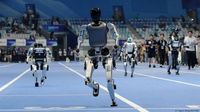More than 500 humanoid robots from 280 teams representing 16 countries have converged in Beijing for the inaugural World Humanoid Robot Games, a spectacle that’s part Olympics, part science fair, and all about pushing the boundaries of robotics. Over three days starting August 14, 2025, these bipedal machines are competing in 26 events—from soccer and kickboxing to medicine sorting and cleaning tasks—at the National Speed Skating Oval, the very arena that hosted the 2022 Winter Olympics.
The opening ceremony set the tone for the weekend, with robots dancing, spinning, and even attempting to play musical instruments alongside their human companions. According to Reuters, the event featured a robot “band” mimicking rock stars, some of whom managed a rudimentary drum beat, though it was unclear whether they were acting autonomously or following human commands. Amid the spectacle, one sequined robot tripped and lay on the stage for a full minute before being gently carried away by human assistants—a scene that drew both laughter and applause from the crowd.
Tickets for the event ranged from 128 to 580 yuan (about $18 to $81), and while the 12,000-seat arena wasn’t packed to the rafters, the audience was treated to a blend of triumphs and slapstick. Robots tumbled, crashed, and sometimes lost parts mid-competition. In the much-anticipated 1,500-meter race, Unitree Robotics—one of China’s rising stars in the field—took first and third place, while X-Humanoid, another local favorite, finished second. Not every competitor made it to the finish: as reported by The Guardian, one robot had to retire after its head fell off mid-race. “Keeping [the head] balanced while in movement is the biggest challenge for us,” explained Wang Zizi, a 19-year-old member of the robot’s development team.
Despite the frequent falls and awkward stumbles, the games have a clear purpose beyond entertainment. As Max Polter, a member of the German HTWK Robots football team, told Reuters, “We come here to play and to win. But we are also interested in research. You can test a lot of interesting new and exciting approaches in this contest. If we try something and it doesn’t work, we lose the game. That’s sad, but it is better than investing a lot of money into a product that fails.”
The competitions themselves have highlighted just how far robotics still has to go before matching human agility and speed. In soccer, robots struggled to coordinate, often bumping into each other and failing to pass the ball with any finesse. According to Live Science, robot footballers mostly “walked into the ball to clumsily knock it forward, occasionally stumbling over each other and having to be dragged off the pitch.” The running events were no less dramatic: the fastest robot completed the 1,500 meters in 6 minutes and 29 seconds—nearly double the human world record of 3 minutes and 26 seconds. And in the kung fu competition, a child-sized robot attempted a complicated move, only to fall and spin on the floor, much to the crowd’s delight.
Yet, the value of the games goes well beyond the arena. Organizers and commentators, as quoted by Reuters, emphasized that these events provide invaluable data for developing robots capable of practical applications. Football matches, for instance, are seen as a way to train robots’ coordination abilities—skills that could one day be essential for assembly line operations requiring multiple units to work in concert. The games serve as a real-world laboratory where failures are as instructive as successes.
The event is also a testament to China’s ambition in the global technology race. The International Federation of Robotics (IFR) noted in a paper released during the games that China has made humanoid robotics the “center of their national strategy.” In March, the Chinese government announced a one-trillion-yuan fund (about $139 billion) to support technology startups, especially those in robotics and artificial intelligence. The games are just the latest in a string of high-profile robotics events hosted in China this year, including what was billed as the world’s first humanoid robot marathon and a live-streamed robot boxing match.
This investment is not just about national pride; it’s also a response to pressing demographic and economic trends. With an aging population and increasing competition from the United States in advanced technologies, China is betting big on robotics as a way to maintain its edge. As Morgan Stanley analysts recently observed, public enthusiasm for robotics in China has surged, with attendance at robotics conferences rising sharply and retail stores dedicated to humanoid robots opening their doors.
The games have drawn participants from a wide range of backgrounds. Of the 280 teams, 192 represent universities and 88 come from private enterprises, including leading Chinese manufacturers like Unitree and Fourier Intelligence. Teams from the United States, Germany, Brazil, and other countries are also present, making the event a truly international affair. According to AFP, teams like the Dutch five-a-side robot football squad have been impressed by the skill and rapid progress of Chinese teams. “I think right now, if they are not already the world leader, they are very, very quickly becoming it,” said Joost Weerheim of the Dutch team.
As the games progress, it’s clear that while robots still have a long way to go before they can match human athletes, their stumbles and falls are all part of the journey. Each tumble provides engineers with new insights, bringing the dream of practical, reliable humanoid robots a little closer to reality. And if the crowd’s cheers are any indication, the world is more than ready to watch—and maybe even lend a hand—along the way.
For now, the World Humanoid Robot Games stand as a symbol of both technological ambition and the humble, sometimes hilarious realities of innovation. The future may not be here just yet, but it’s certainly on the starting line.






